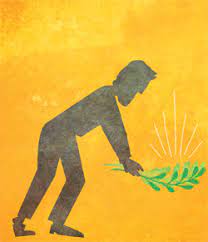
The Midrash tells us that G?d told Abraham: “If atonement is not granted to your children on Rosh Hashanah, I will grant it on Yom Kippur; if they do not attain atonement on Yom Kippur, it will be given on Hoshana Rabbah.”
Isaiah says,1 “They seek Me day [after] day.” The Talmud explains2 that these two “days” refer to the day when the shofar is sounded (Rosh Hashanah) and the day when we take the willow (Hoshana Rabbah)—the day when the heavenly judgment begins, and the day when it concludes.
In addition, on Sukkot we are judged regarding how much rain will fall in the upcoming year.3 Thus, on Hoshana Rabbah, the final day of Sukkot, this judgment is finalized. Considering how much our wellbeing and economy depend on bountiful rainfall, it is clear how important this day is.
To read about the deeper significance of this mitzvah, see One Twig and One Leaf.
The Day of the Willow
The primary observance of Hoshana Rabbah is “the taking of the willow.” In addition to the Four Kinds taken every day of Sukkot, it is a tradition, dating back to the times of the prophets, to take an additional willow on the seventh day of Sukkot. This commemorates the willow ceremony in the Holy Temple, where large eighteen-foot willow branches were set around the altar every day of Sukkot. Every day of Sukkot the altar was circled once, to the sounds of supplications for divine assistance; on Hoshana Rabbah, the altar was circled seven times.
Today, during the course of the Hoshana Rabbah morning services, all the Torah scrolls are taken out of the Ark and are held by people standing around the bimah (Torah reading table). The congregation then makes seven circuits around the bimah (instead of the one circuit done the other days of Sukkot) while reciting the Hoshaanot prayers, with the Four Kinds in hand. At the conclusion of the Hoshaanot we take a bundle of five willows (available for a nominal fee at most synagogues), and with it we strike the ground five times, symbolizing the “tempering of the five measures of harshness.”
It is customary for all—men, women, and even small children—to perform this ritual. One should not use a willow bundle already used by another; a bundle should be purchased for every family member. After the bundle is used, many have the custom of throwing it onto the top of the Ark.
To read more about Hoshaanot, see Winding and Willows.
Other Hoshana Rabbah observances:
Night Learning
In consideration of the auspiciousness of the day, it is customary in many communities to remain awake on the night preceding Hoshana Rabbah. After joyous dancing, we recite the entire book of Deuteronomy, wherein the precepts to love and fear G?d are expounded at length. In certain communities, the entire book of Deuteronomy is read in the synagogue from the Torah scroll. After midnight, the entire book of Psalms is recited. In some congregations it is a custom for the gabbai (synagogue manager) to distribute apples (signifying a “sweet year”) to the congregants. These apples are then taken home, dipped in honey, and eaten in the sukkah.
Morning Prayers
Because of the length of the day’s Hoshaanot prayers, the morning service is a bit longer than the usual Chol Hamoed prayers. However, in many communities (though not in Chabad synagogues), the prayers are augmented with many standard holiday prayers as well as additional liturgy composed specifically for Hoshana Rabbah—and as such, last for several hours. In fact, in certain communities it is even customary to sound the shofar, as a call to repentance, during the course of the prayers.
The Hoshaanot prayers and circuits are done immediately before the reading of the Torah, or in some communities, after the Musaf prayer.
Lekach
The Rebbe would distribute lekach (honey cake) on Hoshana Rabbah, to those who had not received a piece before Yom Kippur (see here for more information on this custom). Click here to watch a video clip of the Rebbe distributing lekach on Hoshana Rabbah of 5742 (1981); and here for Hoshana Rabbah 5749 (1988).
Festive Meal
A festive meal is eaten in the sukkah. We dip the bread in honey for the last time. Many have the custom to eat kreplach—dough filled with ground beef or chicken, folded into triangles—on this day. Click here for a recipe.
Hoshana Rabbah is also the last occasion on which we recite the special blessing for eating in the sukkah, since the biblical commandment to dwell in the sukkah is only for seven days (though it is the practice of many communities—and such is the Chabad custom—that outside of the Land of Israel, we eat in the sukkah also on the eighth day, Shemini Atzeret).
Eruv Tavshilin
In the event that Hoshana Rabbah falls on a Wednesday (so that Simchat Torah will be Thursday night and Friday), an eruv tavshilin must be made on Hoshana Rabbah, to allow cooking and other necessary Shabbat preparations to be done on Friday. Click here for more on this topic and to learn how to make an eruv tavshilin.